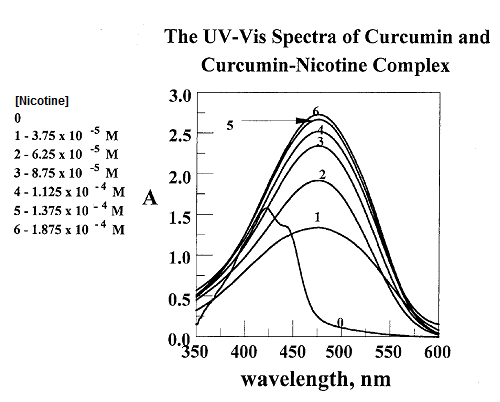
Characterization of curcumin-nicotine interaction in cetyltrimethyammonium bromide micelle
Abstract
Full Text:
PDFReferences
- ChemistryDaily.com 2005.
- http:/www. Woldofmolecules.com/drugs/nicotine.htm.
- M.L. Solt, Plant physiol, 1957, 32, 480-484.
- M.L. Solt, Ibid, 1957, 32, 484-490.
- R.C. Jiloha, Indian. J. Psychiatry, 2010, 54(4), 301-307
- R. Schwartz-Bloom, G.G. de Nunez, www.Pbs.org/wgbh/nova/cigarette/nicotine_nfp.htm.
- S. Banerjee, G. Bandyopudhyaya, K. Chattopadhyay, B.D. Chattopadhyay, In. J. Pharmacol., 2010, 6(4), 444-455.
- J.A. Dani, D. Ji, F.M. Zhou, Synaptic Plasticity and Nicotine Addiction, Neuron, 2001, 31, 349-352.
- D.J. K. Balfour, A.E. Wright, M.E.M. Benwell, C.E. Birrell, Behavioural Brain Research, 2000, 113, 73-83.
- Y. Wang, H.F. Sun, H.F. Wang, Y.F. Liu, Chinese Chemical Letters, 2001, 12(5), 449-452.
- M.N. Tiwani, S. Agarwall, P. Bhatimagan, N.K. Singhall, S.K. Tiwani, P. Kumar, L. Kumar, S. Chaulham,, D.K. Patel, R.K. Chaturwedii, M.P. Singh, K.C. Gupta, Free Radical Biology and Medicine, 2008, 65, 704-718.
- L.T. Sorensen, B.G. Toft, J. Rygaard, S. Ladelund, M. Paddon, T.James, R. Taylor, F. Gottrup, Surgery, 2010, 148(5), 982-990.
- S.K. Mahapatra, S. Das, S. Bhattaacjarjee, N. Gautam, S. Majumdar, S. Roy, Toxicology Mechanisms and Methods, 2009, 19(2), 100-108.
- K. Chattopudhyay, B.D. Chattopudhyay, Indian J. Med. Res., 2008, 127, 571-576.
- M.B. Newman, G.W. Arendash, R.D. Shytle, P.C. Bickford,T. Tioghe, P.R. Sanberg, Life Sciences, 2002, 71, 2807-2820.
- A. Nordberg, E.H. Lindahl, M. Lee, M. Johnson, M. Mousavi, R. Hall, E. Perry, I Bednar, J. Court, J. Neurochem., 2002, 81, 655-658.
- Y. P. Wu, K. Kita, N. Suzuki, In. J. Cancer, 2002, 100, 37-42.
- D. Yildiz, N. Ercal, D.W. Armstrong, Toxicology, 1998, 130, 155-165.
-D.J. Socci, P.R. Sanberg, G.W. Arendash, Neurobiolgy of Aging, 1995, 16(5), 857-860.
- R.D. Shytle, C.V. Borlongan, P.R. Sanberg, Neuropsychopharmacology, 1995, 13(3), 261-264.
- J. Barron, Baseline of Health Foundation, 2010
- C. Kalpana, A.R. Sudheer, K.N. Rajasekharan, V.P. Menon, Singapore Med., 2007, 48(2), 124-130.
- C. Kalpana, V.P. Menon, Pol. J. Pharmacol. 2004, 56, 581-586.
- G.Bandyopadyaya, S. Sinha, B.D. Chattopadhyay, A. Chakraborty, European J. Phrmacol, 2008, 588, 151-157.
- S. Sinha, M. Maiti, K. Chattopadhyay B. Chattopadyay, J. Pharmacol. Toxicol., 2012, 7(4), 166-180.
- X.Z. Cheng, X.S. Yang, L.W. Zhang, Z. Xi, J. Songhai Jiaotong University (Agricul. Science), 2006, 1, 44-47.
- Y. Wang, Y. Cheng, H.F. Sun, Chinese Chem. Letters, 2000, 11(3), 247-250.
- H.A. Benessi, J.H. Hildebrand, J. Am. Chem. So., 1949, 17, 2703-2707.
- M. Riri, O. Kamal, A. Benjjar, F. Serdaoui, M. Hlaibi, Open J. Phys. Chem. 2013, 3, 49-58.
DOI: http://dx.doi.org/10.13171/mjc.3.1.2014.12.04.16
Refbacks
- There are currently no refbacks.
Copyright (c) 2015 Mediterranean Journal of Chemistry
